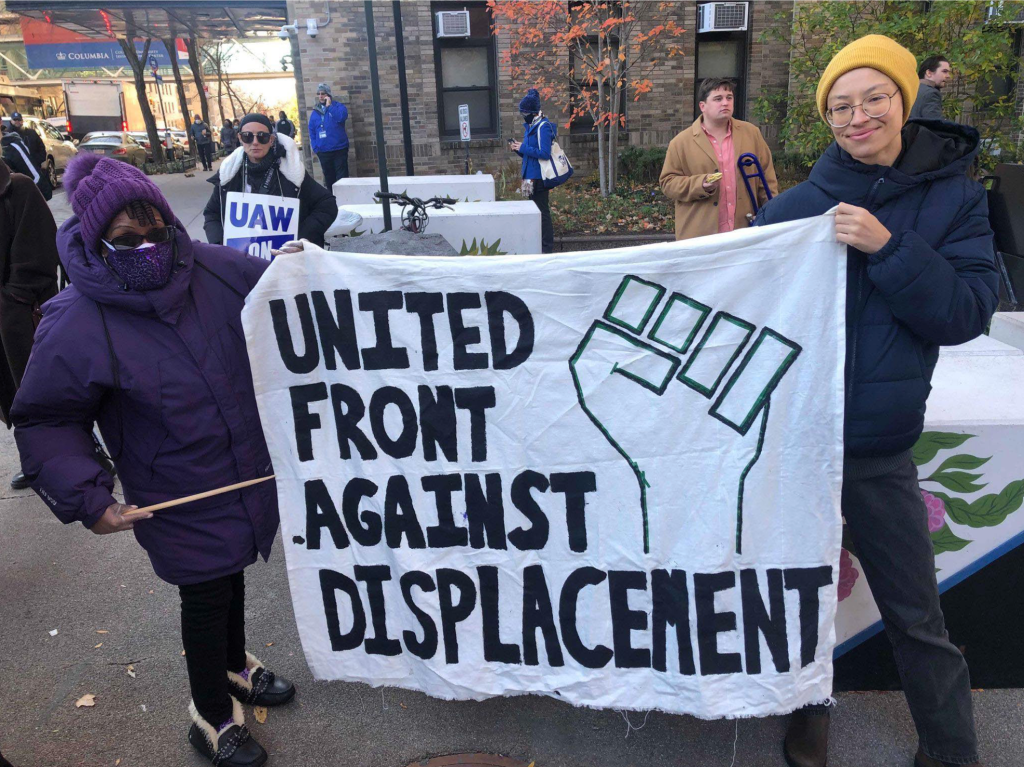Dec 2021-Jan 2022
By UFAD New York Branch

In November, UFAD Harlem residents joined protests at Columbia University’s main campus in Morningside Heights to support the graduate student strike. For weeks, students held a daily picket on the campus’ central square to demand a new contract, better payment, and health care. Members of UFAD in Harlem, who are fighting against the privatization of public housing projects, joined the actions to support the student workers and to spark opposition to the school’s expansion into Harlem, only the latest chapter in the school’s decades-long plan to further their stake in real estate development and privatization in surrounding neighborhoods.
At pickets UFAD Harlem members gave speeches about their first-hand experience with privatization, stating that Harlem residents saw the need to unite with the students and campus workers to oppose the corporate-controlled university board. In the following weeks, Columbia students came to a UFAD Harlem event to support residents’ fight against privatization, and several Harlem residents joined the students’ fundraising activities to further solidarity.
Despite the fact that Columbia University occupies properties in Harlem, where it has aggressively expanded its real estate holdings in recent years, the solidarity between students and residents was real, grounded in residents’ and students’ awareness of Columbia University’s real estate plans. These plans will bring profits for the institution, but from the perspectives of students and residents are furthering a housing crisis in Harlem at the expense of locals.
In a march organized by the students on December 1st, UFAD members held signs stating “Columbia University Get Out of Harlem.” At another rally, students told UFAD members that graduate students were not only underpaid but also charged with unaffordable high rent in the school’s residential facilities, which are built on privately purchased land in Harlem. In this sense, it is clear that the school would rather spend more money to invest in expanding in Harlem than pay the bills for its own students. Both Harlem residents and Columbia University students are fighting against the same crisis-ridden capitalist economy, on distinct but related fronts. To achieve true victory, these fronts must be linked up.

At first glance Columbia University, an institution of higher education, is an innocent bystander in the area’s housing crisis, but this is far from the case. As a BUSINESS entity, Columbia University has a notorious history of profiting from speculation on property values in Harlem by expanding its private territory there, bringing about dire consequences for locals. Still fresh in people’s memory is the school’s recent private purchase of land and property in West Harlem as part of its “Thirty-Year plan,” which displaced hundreds of households and businesses to pave the way for the school’s new lab buildings: (See: https://unhabitat.org/sites/default/files/download-manager-files/NYC%20Case%20Study.pdf). Yet another recent case is the school’s northward expansion into the junction between Broadway and 125th Street.
As a cultural institution that defends the interests of the ruling elites in society, the university wears a progressive mask to cover over their real estate maneuvers in the neighborhood. The school hung a Black Lives Matter sign outside their lab building on 125th street, visible from the elevated 1 train, a mockery hanging on a building that displaced hundreds of Black residents. The construction only became possible by pushing out Harlem residents. Like the Museum of Chinese in America (MOCA) in Chinatown, the landlord here, the board of Columbia University, uses politically correct language to conceal the predatory interests of the institution in the neighborhood.

Despite the hopes of the school’s board of directors that its plans to expand into Harlem would go smoothly, they have not. They have met with opposition from the people of Harlem. Besides the protests initiated by Harlem residents in the last two decades, the people have fought against this landlord/university since back in the 1960s. The famous 1968 shutdown of campus was achieved as part of a movement opposing the school’s “G-Y-M Crow”—a plan to construct a university sports facility in Harlem accompanied by mass evictions of local residents.
This plan by the university was defeated, showing how the people united can defeat such predatory business schemes. Today Harlem residents and Columbia University students are supporting each other to form a united front and together sweep away into the dust bin “Ivy Imperialism” – a term coined by activists and residents in the 1960s for describing Columbia University’s administrators and their friends in the ruling class.
